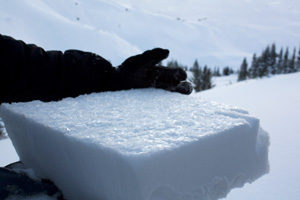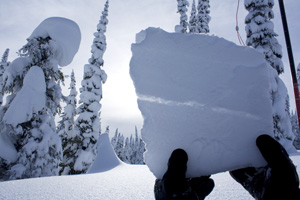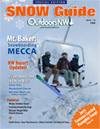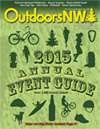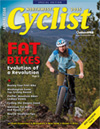Raising Avalanche Awareness in the Pacific Northwest
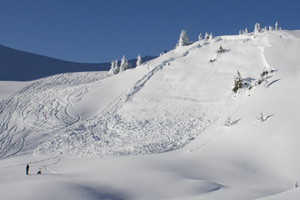
Story by Suzanne Johnson
Photos by Daniel Dorres
Photo at right: Skiers trigger a slide on a clear day.
What started as a typical backcountry day for Bend, Ore. locals John Menefee and Greg Miller turned into an unforgettably close call. Following a two-day snowstorm, they skinned up Tumalo Mountain, in Central Oregon, to enjoy the fresh snow.
“I knew there was some wind-loading,” says John, “but I ski that area often and have never seen it slide. I got complacent.”
Greg headed down first, starting with a hard ski cut across the bowl. John followed, and on his third turn the snow began to crumble around his feet. “I bee-lined it out to the trees on the left—my island of safety—and watched the crown slide into a debris field 50 yards across.”
John and Greg, who wore beacons and have had avalanche training, were left unnerved but unharmed, with renewed dedication to evaluating avalanche risks. Their experience is becoming more common, as greater numbers of snow-riding enthusiasts venture beyond the avalanche-control blasts that keep ski resort runs safe from slides.
Determining the exact number of backcountry users is a difficult endeavor, yet the increasing sales of backcountry equipment indicate the growing popularity. According to Snowsports Industries America (SIA) the sale of AT/Randonee equipment increased 87 percent during the 2010/2011 season, and snowshoe sales increased by over 20 percent.
Safe out-of-bounds exploration requires more than the right gear. Awareness of avalanche conditions, understanding how to avoid avalanches, and training for emergencies are all critical components of responsible backcountry recreation, and organizations around the Pacific Northwest are connecting backcountry enthusiasts with the experts who provide snow science and teach essential skills.
The science of slides
At the Northwest Weather and Avalanche Center (NWAC), three meteorologists are dedicating their careers to the analysis of avalanche-prone conditions and to effectively communicating that information. Funded by a partnership of agencies, including Washington’s Department of Transportation, and administered by the U.S. Forest Service, the NWAC provides the forecasting and weather analysis critical for evaluating avalanche risk.
Mark Moore, NWAC Director, spends about a third of his time in the field, gathering data on snowpack conditions from Mt. Hood to the Washington Cascades. His remaining time is spent interpreting and disseminating that information via their website, for use by backcountry guides and off-piste adventurers.
The NWAC uses a diagram known as the Avalanche Danger Rose to graphically represent risk levels for a specific locale. The Danger Rose conveys critical forecasting information through colors, compass points, elevation numbers, and arrows over a set of concentric circles, which represent a topographic perspective of a mountain.
 “Avalanche conditions in coastal mountain ranges differ greatly from those found in the Rockies,” says Moore. “Our persistent warming and cooling cycles create extremely fragile snowpack layers.”
“Avalanche conditions in coastal mountain ranges differ greatly from those found in the Rockies,” says Moore. “Our persistent warming and cooling cycles create extremely fragile snowpack layers.”
Because of the great variability in weather and other factors, Moore emphasizes the need for backcountry users to connect to local groups and learn to “read between the lines” to interpret how snowpack and micro-climate might affect local terrain.
Avalanche awareness on a local level
While the NWAC focuses on gathering data and generating forecasts, other organizations work to raise awareness of, and access to, avalanche education. In Washington, the Friends of NWAC fills the role of connecting individuals to the professionals who teach novices how to interpret the danger rose, evaluate conditions on site, and use safety equipment (beacons, probes, and shovels) should an emergency arise.
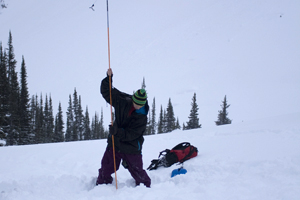
A participant in an avalanche training class searches for a backpack with avalanche beacon hidden in the snow.
In Oregon, the Central Oregon Avalanche Association (COAA) is growing into a valuable resource for backcountry skiers and snowmobilers exploring the volcanic peaks of the Central Cascades. Local backcountry enthusiasts, including Trevor Miller, Betsy Nelson, and Jon Tapper, founded the non-profit organization in 2010, with the goal of creating a grassroots forum on regional backcountry conditions.
COAA’s interactive website allows users to submit observations of snowpack conditions and avalanche incidents; the monthly meetings and fundraising film festivals have created a cohesive backcountry community.
“We’ve seen an amazing response from the local professionals, such as Timberline Guides and Search and Rescue,” notes Jon Tapper, COAA Vice President. “The industry has also really supported us with gear giveaways and raffle items for fundraisers.”
COAA has adopted the “Know Before You Go” program, originally developed by the Utah Avalanche Center, which includes a video presentation followed by discussion pertinent to the region.
“Details like which cell phone carriers have service in which backcountry areas—that can be critical to survival,” explains Tapper. COAA plans to extend its outreach by installing signage at Central Oregon’s three most popular backcountry trailheads: Dutchman Flats, Newberry Crater, and the Three Creeks
Wilderness. Each sign will remind users to turn on beacons, and include a solar-powered device to test beacon signals.
A positive impact on backcountry safety
Do avalanche awareness efforts make a difference? Mark Moore thinks so.
“We still hear too many tragic stories of fatalities from avalanches,” says Moore. “Yet that number has leveled off — it’s not keeping up with the growth in backcountry users.” This difference may indicate that a growing percentage of new backcountry users have been educated on how to avoid dangerous conditions — a trend that motivates avalanche awareness groups to continue on with their efforts. As Tapper notes, “We want every backcountry visit to be a round trip.”
Resources:
Northwest Avalanche Center: www.nwac.us
Central Oregon Avalanche Association: www.coavalanche.org
SnowSports Industries of America: www.Snowsports.org
Suzanne Johnson lives, writes, and plays in the Cascades of Central Oregon. Find more of her published stories at SuzanneMyhreJohnson.com

